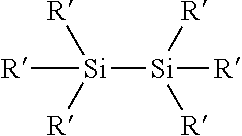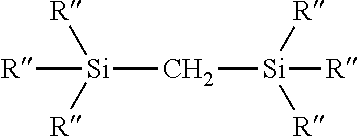Process for the production of organohydridochlorosilanes
a technology of organohydridochlorosilane and hydridosilane, which is applied in the field of production of organohydridochlorosilane, can solve the problems of reducing the yield of the desired chlorohydridomethylsilane, requiring an expensive metal catalyst, and comparatively low percent of hydridosilane obtained in such processes
- Summary
- Abstract
- Description
- Claims
- Application Information
AI Technical Summary
Benefits of technology
Problems solved by technology
Method used
Image
Examples
example 1
[0241]Dimethyldihydridomonosilane (1.0 mmol) and dimethyldichloromonosilane (1.5 mmol) were mixed in a molar ratio of 41 to 59 (given in mol-% as educt mixture in Table 2) with a catalytic amount of the redistribution catalyst PPh3 (0.02 mmol) in diglyme (0.35 ml) as solvent in an NMR tube, solidified at −196° C. (liquid nitrogen) and sealed in vacuo. After warming the samples to r.t., 29Si- and 1H-NMR spectra were measured to prove the degree of SiH / SiCl redistributions after different reaction times and temperatures to control and quantify product formation by integration of the intensity of relevant NMR signals within the mixture. The product yields are given in mol-% in Table 2.
[0242]
TABLE 2educt 80° C. 120° C. + 140° C. + 160° C. + no. silane (%) 2 h 21 h 48 h 160 hI Me2SiH2 41 41 36 13 13 II Me2SiCl2 59 59 59 33 29 Ill Me2SiHCl ——5 54 58
[0243]Silanes I and II started to react at 120° C. (21 h) to give the targeted product III in an amount of 5%. With prolonged reactions times ...
example 2
[0244]Dimethyldihydridomonosilane (1.0 mmol) and dimethyldichloromonosilane (1.3 mmol) were mixed in a molar ratio of 44 to 56 (given in mol-% as educt mixture in Table 3) with a catalytic amount of the redistribution catalyst n-Bu3P (0.2 mmol) in diglyme (0.35 ml) as solvent in an NMR tube, solidified at −196° C. (liquid nitrogen) and sealed in vacuo. After warming the samples to r.t., 29Si- and 1H-NMR spectra were measured to prove the degree of SiH / SiCl redistributions after different reaction times and temperatures to control and quantify product formation by integration of the intensity of relevant NMR signals within the mixture. The product yields are given in mol-% in Table 3.
[0245]
TABLE 3educt 80° C. 120° C. + 140° C. + 160° C. + no. silane (%) 2 h 21 h 48 h 160 hI Me2SiH2 44 44 45 18 15 II Me2SiCl2 56 56 51 33 26 Ill Me2SiHCl ——4 49 59
[0246]Similar to Example 1, redistribution reactions started to occur at 120° C. (21 h) to give III in an amount of 4%. The maximum amount of...
example 3
[0247]LiH (1.5 mmol), Me2SiCl2 (1.6 mmol), diglyme (0.4 ml) and a catalytic amount of PPh3 (0.02 mmol) were placed in an NMR tube that was cooled to −196° C. (liquid nitrogen). After evacuation in vacuo the NMR tube was sealed and warmed to r.t. The starting materials reacted upon heating the sample, and the reaction course of the chlorosilane reduction / redistribution reaction was monitored by NMR spectroscopy.
[0248]
TABLE 4no.silane120° C., 13 h160° C., +22 h160° C., +40 hIMe2SiH2321411IIMe2SiCl2664733IIIMe2SiHCl23956
[0249]As can be seen from Table 4, the formation of Me2SiHCl III was steadily increasing with increasing reaction temperature and time. The maximum amount of chlorosilane III formed by redistribution of hydridosilane I with dichlorosilane II was 56% after 62 h at 160° C.
PUM
| Property | Measurement | Unit |
|---|---|---|
| temperature | aaaaa | aaaaa |
| boiling point | aaaaa | aaaaa |
| boiling point | aaaaa | aaaaa |
Abstract
Description
Claims
Application Information
 Login to View More
Login to View More - R&D
- Intellectual Property
- Life Sciences
- Materials
- Tech Scout
- Unparalleled Data Quality
- Higher Quality Content
- 60% Fewer Hallucinations
Browse by: Latest US Patents, China's latest patents, Technical Efficacy Thesaurus, Application Domain, Technology Topic, Popular Technical Reports.
© 2025 PatSnap. All rights reserved.Legal|Privacy policy|Modern Slavery Act Transparency Statement|Sitemap|About US| Contact US: help@patsnap.com



